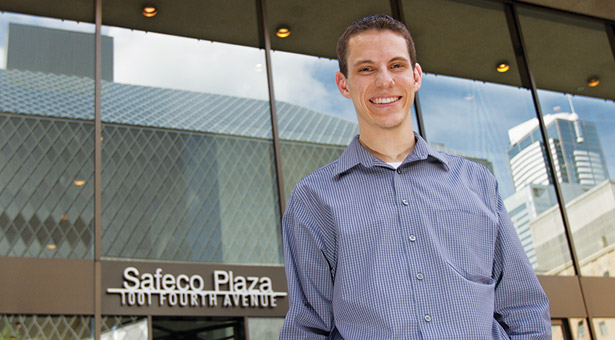Business A Tool to Serve the World
Fund Gives Students Real-Life Investing Experience
To Market, To Market
By Clint Kelly (ckelly@spu.edu) | Photo by Mike Siegel

A product analyst for Safeco Insurance in Seattle, Ethan Moody ’13 says the insurance industry is a great place to work with people and data to assess and quantify risk.
Ethan Moody ’13 approaches stock market investing with several vital tools in his toolkit. He possesses an investigative mind, monitors key metrics to assess the health of the U.S. economy, and thanks to his study of economics at Seattle Pacific University, knows to take a measured and disciplined approach to minimize risk.
One of his keenest assets came into play as vice president of operations for the SPU Student Investment Fund: the ability “to identify your own biases and temper them with good information.”
The SIF was established two years ago when junior James Cannariato approached Don Mortenson, now senior vice president for planning and administration at SPU, to see if students could invest a portion of the University’s endowment. Administrators reviewed the proposal, developed guidelines and precautions, and then agreed to place $100,000 under student management.
“I was impressed with James’ energy and goals when he presented the idea. He was understanding of the kind of stewardship care that is needed with such funds of the University,” Mortenson says. “This seemed to be a good opportunity to provide students with more than a textbook education.”
Student investment funds are a common practice. Hundreds of colleges and universities across the nation allow selected students to gain real-world investment experience by managing institutional funds.
“We place some limits,” says Professor of Finance and SIF Advisor Dan Hess. “The companies in which our students invest must be large, well-established companies approved by me, and the makeup of the fund wouldn’t be that different from the typical mid- to large-cap fund.” No options, no futures, and no margins allowed. And each of the dozen students in the Fund, who had an average GPA of 3.75 last academic year, must do their research and prove to the group through supporting data that a chosen company is a solid investment. The case is made; a vote is taken; and the majority wins.
“My biggest takeaway from Dr. Hess,” says Moody, who after graduation took a product analyst position with Safeco Insurance, “is that anyone can become a good investor by maintaining a long-term mindset.” Much of his market savvy was honed through courses with Hess and in investment-fund leadership. His experience with the other students in SIF allowed him the unique opportunity to practice “righteous stewardship” over resources that were not their own.
The “value investing” strategy of the student investors means they buy and hold stocks for a longer period of time, as opposed to trading or selling stocks rapidly in response to daily price swings. Since its inception on May 14, 2012, the money under SIF management has grown by almost 13 percent.
While SIF members change, the investment portfolio goes on. Hess says that in the future, the Fund may generate student scholarships and perhaps incorporate socially responsible criteria for its investments. What is not in question is the educational value of taking what is learned in the classroom and putting it into action in the stock market.
Yet to invest any of his own money in the market, Moody is eager to exercise his option to invest a portion of his paycheck in his company’s 401K plan. He hopes managing those funds will provide still more experience to reach his goal of becoming a chief actuary or chief risk officer.
